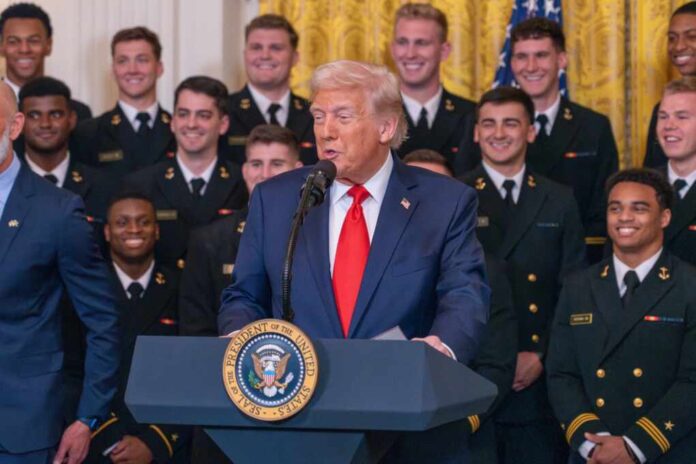
President Trump signs sweeping executive order to strengthen law enforcement with military equipment, increased resources, and legal protections for officers on the frontlines.
At a Glance
- Trump’s executive order directs the Department of Justice to prioritize legal resources and protections for police officers
- The order calls for distribution of surplus military equipment to local law enforcement agencies
- It aims to reverse “equity” policies perceived as contributing to rising crime rates
- Enhanced federal and local coordination through Homeland Security Task Forces is emphasized
- A federal judge has already blocked attempts to cut funding to sanctuary cities
Bolstering Police Resources and Protections
President Donald J. Trump has signed a comprehensive executive order designed to empower state and local law enforcement agencies with increased resources to combat crime. The directive specifically instructs the Attorney General to provide legal resources for officers, improve training programs, increase officer pay, and strengthen legal protections. This move represents a significant shift in federal policy toward law enforcement, prioritizing support for officers who have faced increasing challenges in recent years while performing their duties to protect communities nationwide.
A key component of the order involves indemnifying officers involved in lawsuits resulting from their duties, potentially providing them with substantial legal support against claims. Additionally, the order calls for a comprehensive review of federal consent decrees that have placed restrictions on certain police departments. These consent decrees have been criticized by supporters of law enforcement as hampering officers’ ability to effectively police high-crime areas and respond to escalating criminal activity.
America has the greatest military in the world, and President @realDonaldTrump continues to bring our troops home! pic.twitter.com/vtE18GzyNB
— The White House 45 Archived (@WhiteHouse45) August 20, 2020
Military Equipment and Enhanced Capabilities
The executive order directs federal agencies to provide surplus military assets to local law enforcement agencies, a policy that represents a reversal of restrictions placed on such transfers by previous administrations. This provision aims to improve the capabilities of police departments nationwide by giving them access to equipment that can assist in high-risk situations. The order also emphasizes the use of Homeland Security Task Forces to create better coordination between federal agencies and local law enforcement, streamlining efforts to combat crime across jurisdictional boundaries.
The White House fact sheet on the executive order specifically mentions that these measures are intended to address what the administration describes as rising crime rates and the negative impact of policies perceived as being soft on crime. The order takes direct aim at what it characterizes as “illegal race- and sex-based ‘equity’ policies” that have been implemented in various jurisdictions across the country. According to the administration, these policies have hampered effective law enforcement and contributed to public safety concerns.
— Leviathan News (@leviathan_news) April 28, 2025
Confronting Legal Challenges
The executive order comes as part of Trump’s broader agenda to “Make America Safe Again,” which includes actions to seal the border, deport criminal illegal aliens, and designate certain violent organizations as terrorist entities. However, the implementation of these policies faces significant legal hurdles. A federal judge has already blocked the administration from cutting funding for cities with sanctuary policies, citing violations of the separation of powers and the Spending Clause of the Constitution.
The Justice Department has also taken legal action against jurisdictions with sanctuary policies, including filing lawsuits against the City of Rochester and New York’s Green Light Law. These legal confrontations highlight the tensions between federal immigration enforcement priorities and local governance decisions. A recent case in Milwaukee County involved charges against a judge for allegedly interfering with federal law enforcement related to a Mexican national, further illustrating the complex jurisdictional issues at play.
The executive order represents a significant shift in federal law enforcement policy, with an emphasis on providing greater resources and protections to officers while holding state and local officials accountable for policies the administration believes obstruct effective criminal law enforcement. As implementation begins, legal challenges are likely to continue, particularly regarding the balance of federal authority and local control in law enforcement matters.

























